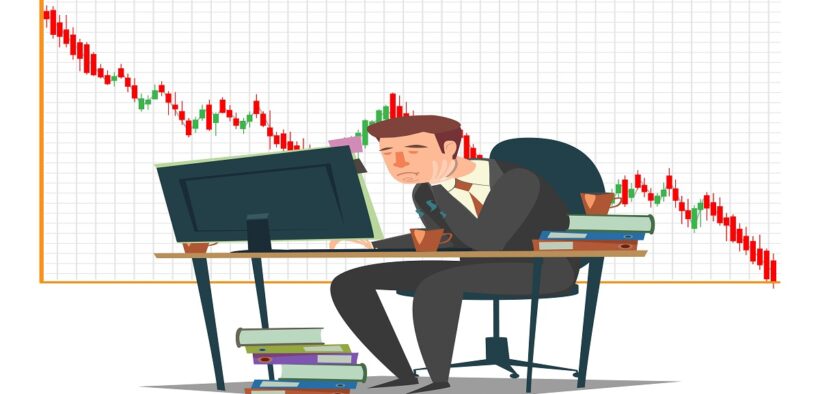Are You Over-trading? – Here’s How to Stop!
Share

You’re spending so much time trading Foreign exchange and getting some successes. Yet in some way, every month, you’ve been left with a loss of revenue. What’s happening?
Over-trading is possibly and probably the most common trading mistake that Forex traders make. This information will fully explore over-buying and selling and supply some solid guidelines to help you overcome this very destructive emotional buying and selling problem.
Here’s the best way to judge if you’re over-trading, and the best way to repair it if you’re.
Are you over-trading?
The list below provides you with an introduction to overtrading warning signals.
1. Taking bad quality trades
When traders do not have “enough” trades they frequently begin taking trades that do not adhere to their strategy as well as their hard rules. They take trades they’d otherwise discard as not too good or otherwise so obvious. However, when there aren’t a lot of buying and selling possibilities, such not-so-good signals start looking more desirable for them. This need not be intentional, it is only how a mind works – it adapts. It essentially informs you: “Well buddy, there isn’t a lot of nice buying and selling possibilities at this time so if you wish to trade, you have to decrease your standards”. So slowly and gradually you decrease your standards. Usually, you will not even notice that you’re taking low-quality signals (and turning them into losing trades).
What’s the way using this? The very best factor you should do is to consider screenshots of the trades and undergo them every so often. By doing this you’ll remember the way the good trades and signals seem like. You will not be subconsciously cutting your standards and also you will not be taking low-quality signals. You’ll be only taking trades that are identical quality as that relating to your screenshots.
2. Buying and selling assets you’ve little knowledge about
Another manifestation of forcing trades is searching for signals among buying and selling instruments you’ve little if any knowledge about. Should you, for instance, daytrade EUR/USD and USD/JPY, a typical example could be should you began searching for buying and selling possibilities for your house on GBP/JPY, DAX, or OIL. Every buying and selling instrument or foreign exchange pair features its specifics, volatility, and behavior. You can’t expect that if you’re familiar and lucrative around the EUR/USD you’ll instantly be effective buying and selling US indexes. Well, you may be, but you have to dedicate serious amounts of backtesting and training using the new group of buying and selling instruments first. You cannot start buying and selling much like you might expect success. It’s okay to grow and discover to trade new buying and selling instruments but doesn’t jump into buying and selling them with no proper preparation.

So when enticed to trade newer and more effective buying and selling instruments, it is crucial that you’re doing so gradually and you do your preparation and backtesting first. Don’t dive in only as you have a desire to trade more.
3. Searching for trades on lower timeframes
When traders seem like they wish to take more trades, they frequently look for them on lower timeframes. Individuals indeed provide them with more buying and selling signals and trade possibilities. The low the time-frame the greater signals you receive. Regrettably, the caliber of the signals goes lower. Particularly if such traders don’t have any knowledge about the low timeframes they make an effort to trade. Honestly, should you trade swing trades using 4-hour charts, then you definitely will not be generating money should you change to 1-hour charts. You’ll have more trades, yes. However, your winning ratio goes lower seriously.

If you’re familiar with lower timeframes then it’s completely okay, however, you can’t just change to reduced timeframes and with no experience begin to play a different game. What’s going to happen is you will begin taking more trades and you’ll start losing increasingly more money.
The safest strategy is just that you follow your time-frame as well as your usual method of buying and selling. Don’t switch timeframes simply because you need to trade more. Not without correct preparation, backtesting, and training.
4. Trading inside a tight range
Once the markets lose their usual volatility plus they go sideways or perhaps in a good funnel it’s pretty dangerous to spread out trades. Even though your buying and selling levels or signals may look great, the gain potential is decreased due to the tight range. This is very common for instance around the AUD/USD. It’s my job to daytrade this pair with 10 personal injury protection Profit Target and 12 personal injury protection Stop-loss. AUD/USD sometimes becomes very calm also it loses its volatility. Inside a situation such as this, I favor not take any trades there because 10 personal injury protection reactions (my usual Profit Target) means for instance 1 / 2 of the daily volatility. I am unable to expect that the intraday level causes the cost to create fifty percent of daily volatility. ten percent or twenty percent yes, but fifty percent is quite a bit. It takes place only rarely that cost reacts for an intraday level so strongly.
So, when the volatility drops lower, then it is advisable to avoid buying and selling even if you’re receiving targeted buying and selling signals. Keep in mind that it’s not necessary to trade. It’s okay to spend some time and hold back until the volatility will get normal again.
How to avoid overtrading
To prevent overtrading, it is advisable to possess a comprehensive buying and selling plan and risk management strategy in position. There are also other measures you can take, namely:
- Avoid emotional buying and selling: separate rational and emotional buying and selling decisions, and support your decisions with obvious analysis.
- Diversify your portfolio: should you frequently have several positions open, you can assist minimize risk by distributing neglect across asset classes.
- Just use that which you have: choose how much you need to risk, but never trade using more capital than you really can afford to get rid of.
With regards to your buying and selling plan, talk about your objectives and motivation, the money and time available for you, risk management as well as your market understanding.
Goals and motivation
Outline what drives you to trade. Will it be for potential profits? Or perhaps is it really to understand more about how markets work? It’s important not only to write lower why you need to be considered a trader but additionally which kind of trader you need to be. You will find four common buying and selling styles, namely scalping, day buying, and selling, swing buying and selling and position buying and selling.

Finally, you need to log your every day, weekly, monthly and yearly targets.
Money and time
Decide the length of time and cash you need to invest in buying and selling. Make sure to element in time it’s important to prepare, find out more about the markets, analyze financial information and practice on the demo account. Then, decide the amount of your hard-earned money you can commit to buying and selling. Never take more chances than you really can afford to get rid of.
Risk management
Choose how much risk you’re to defend me against. All financial assets carry risk, but it’s your decision how aggressive your risk strategy is going to be. Risk management includes outlining your chosen stops, limits, and risk-reward ratio on risk management.
Market understanding
Before you begin buying and selling, it is crucial that you simply do your quest around the markets and write lower your learnings. Evaluate your expertise and interest before you decide to jump into buying and selling and buying and selling diary to understand your past mistakes.
No matter what you read or do, there will be moments of madness in any trader’s career. Trading requires incredible discipline. Keep trying, making mistakes and stay disciplined.











